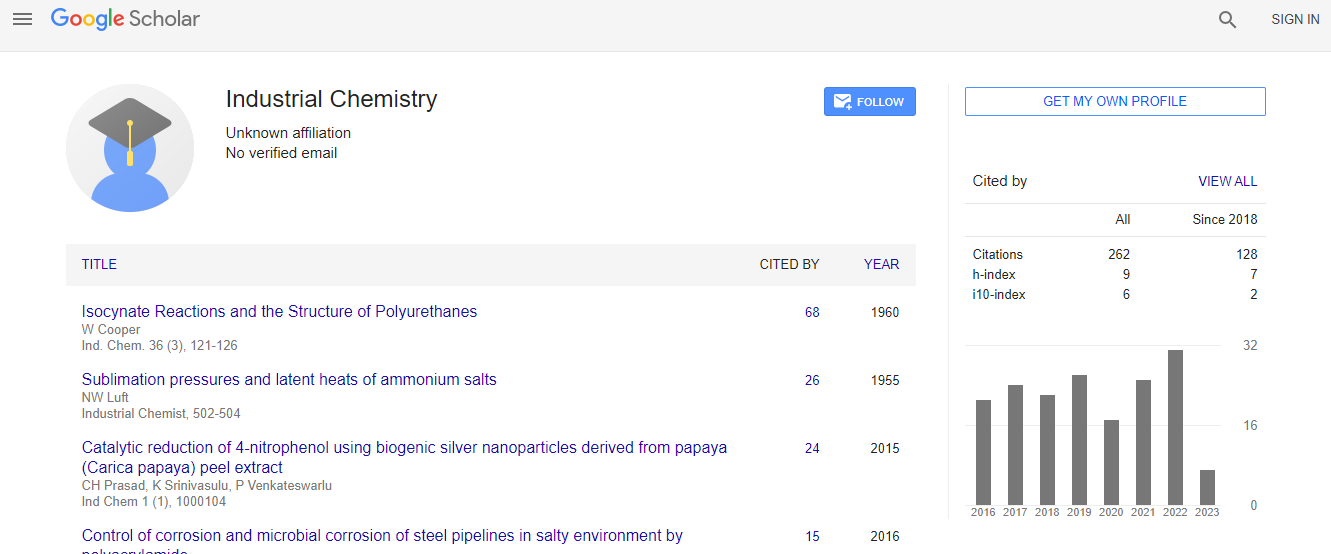Our Group organises 3000+ Global Conferenceseries Events every year across USA, Europe & Asia with support from 1000 more scientific Societies and Publishes 700+ Open Access Journals which contains over 50000 eminent personalities, reputed scientists as editorial board members.
Open Access Journals gaining more Readers and Citations
700 Journals and 15,000,000 Readers Each Journal is getting 25,000+ Readers
Google Scholar citation report
Citations : 262
Industrial Chemistry received 262 citations as per Google Scholar report
Indexed In
- Index Copernicus
- Google Scholar
- RefSeek
- Directory of Research Journal Indexing (DRJI)
- Hamdard University
- EBSCO A-Z
- OCLC- WorldCat
- Scholarsteer
- Geneva Foundation for Medical Education and Research
- Euro Pub
Useful Links
Recommended Journals
Related Subjects
Share This Page
Investigation of the efficiency of conventional water treatment processes for the elimination of TOC in Jalaliyeh water treatment plant, Tehran, Iran
2nd World Conference on Industrial Chemistry and Water Treatment
Ali Asghar Najafpoor, Hossein Kiashemshak, Amir Hossein Mahvi and Ahmad Hosseinzadeh
The University of Newcastle, Australia Mashhad University of Medical Sciences, Iran Tehran University of Medical Sciences, Iran
Posters & Accepted Abstracts: Ind Chem
Abstract
Background: The organic compounds presence in water is considered as a key resource for the formation of trihalomethanes (THMs) and mutagenic substances. Objectives: The chief motivation behind the present investigation was to examine the efficiency of Jalaliyeh water treatment plant in removal of total organic carbon (TOC). Method: The water samples including raw water, the effluent after accelerator and the effluent after filtration were taken during 6 months. Two days from each week were selected in each, of which three samples were taken from the three points mentioned above. In other words, 24 samples in each month and totally 144 samples were collected during the whole study period. The measurement of TOC was performed by means of spectrophotometer at a wavelength of 555 nm. Results: When the input TOC was at its maximum value, TOC removal efficiency was about 80% which can be increased by augmentation of the amount of coagulant substance or use of coagulant aid. The removal efficiency was declined by decreasing the concentration of TOC input. Conclusion: The accelerator had an acceptable efficiency for the elimination of TOC. The samples taken after rainy days showed an increased amount of input organic matter, especially TOC, into the treatment plant compared to the days without rainfall.Biography
Ali Asghar Najafpoor has joined the University of Newcastle in July 2016 for sabbatical leave period. Prior to joining the University of Newcastle, he has worked as an Associate Professor of Environmental Health, Mashhad University of Medical Sciences, Iran. He is an innovative Researcher with a remarkably wide and indepth knowledge of environmental pollution control and remediation. Research conducted by him and his colleagues have demonstrated that pollutants complexes and some sorbed pollutants are bioavailable and this work has major implications for the toxicity, risk assessment and remediation of pollution in environment.

 Spanish
Spanish  Chinese
Chinese  Russian
Russian  German
German  French
French  Japanese
Japanese  Portuguese
Portuguese  Hindi
Hindi 